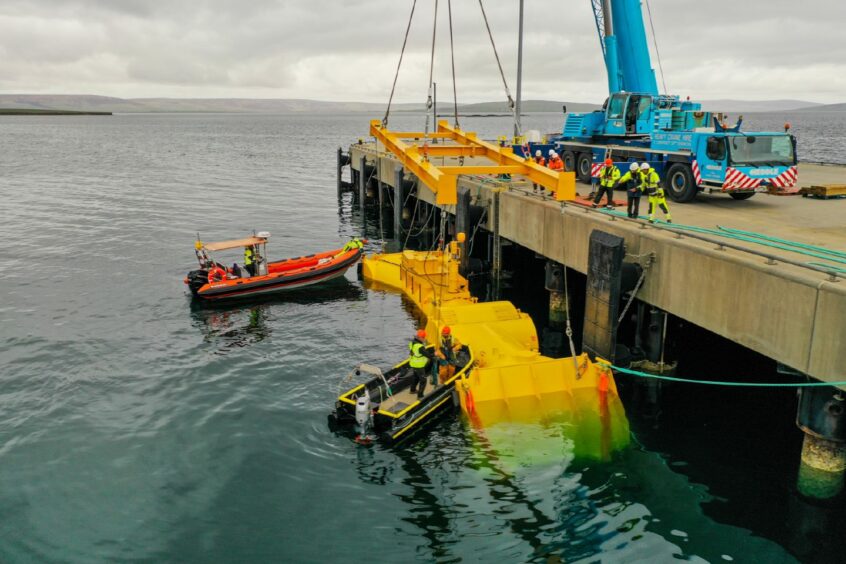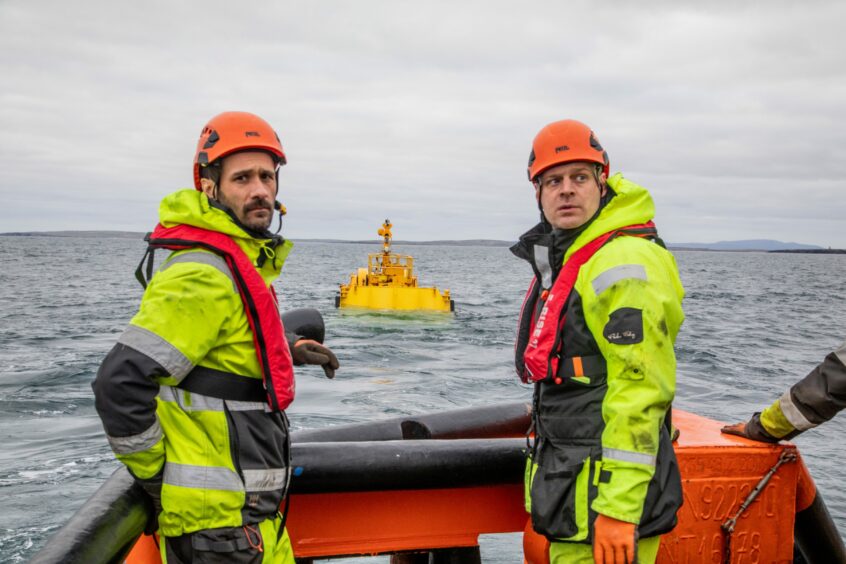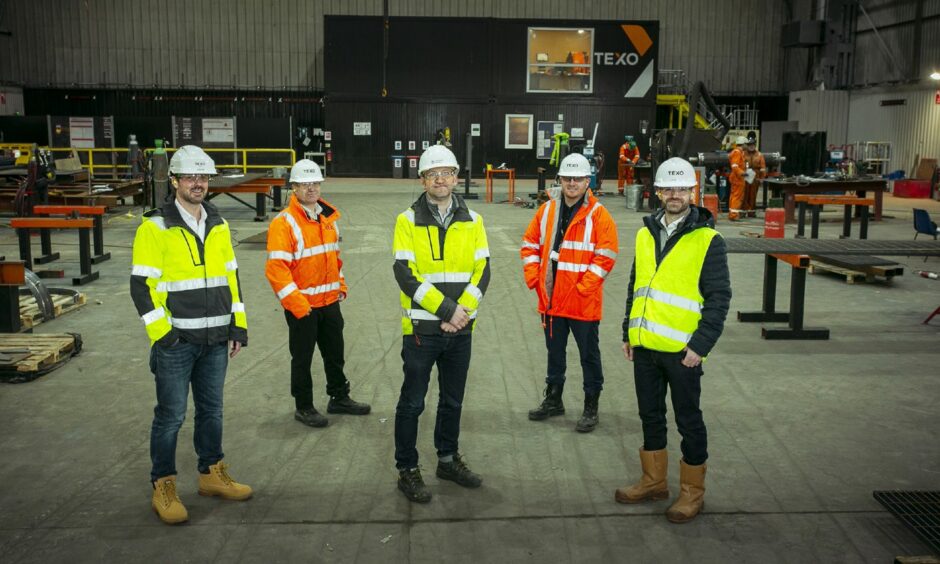
The past 12 months have seen wave technology firm Mocean Energy go from strength to strength, as a major demonstrator project off Orkney paves the way for commercial deployments.
Not content to slow down, the Edinburgh-headquartered firm has managed to tuck an equity raise, a major demonstrator project and a vital manufacturing framework under its belt in the first few months of 2023 alone.
Looking back on the past year, commercial director Ian Crossland says onshore testing of its Blue X wave energy converter in tandem with other subsea technologies as “a really key inflection point” which has given the firm confidence to take the system out to sea trials last month.
The £2 million demonstrator project, dubbed Renewables for Subsea Power (RSP), sees the device deployed alongside a Halo underwater battery developed by Aberdeen subsea tech firm Verlume as part of a four-month test programme. During the scheme the systems will provide power and communication to subsea infrastructure, including Baker Hughes subsea controls equipment and a resident underwater autonomous vehicle provided by Transmark Subsea.
The hope is that real-world trials will help advance the system’s technology so-called readiness level (TRL) to 6-7 – a key rating that would give potential customers confidence in buying future commercial models.
Despite some weather-related setbacks – “Deploying offshore in any location in the winter is not great let’s be honest -it’s always challenging,” Mr Crossland said – the device is now performing within expectations – and at points to its limits.
“In the last few weeks we’ve seen some really significant wave heights, close to five metres, which has been really awesome in that particular area,” he continued.
“Six metres is pretty much the typical maximum height that we tend to see, so we’ve already experienced that quite early on in the project and the whole system has been working really, really well and we’re really pleased with that.
“It’s given us much more confidence as we go into the next steps,” he said, adding that with initial work completed the scheme will soon see an AUV deployed with the system for testing within the next few weeks.
And while the project is, for now, contained to Orkney, its scope and scale have been felt far wider.
“The level of interest that the project has been attracting from partners outside of the UK has been phenomenal,” he continued. “And there’s a lot more interest homegrown here as well in the UK.”
That could even see an expansion of the testing programme to include new partners at a later date, though he notes that for now the site is consented until the end of June.
Growing together
Recent weeks have also seen the firm sign a memorandum of understanding with TEXO Engineering and Fabrication, which would see the firm’s Dundee yard handle fabrication, assembly and load-out for future Blue Star and Blue Horizon devices.
Mr Crossland says Mocean’s roadmap would see solutions built to tackle three scales he dubbed ‘small, mid and grid’ – ranging from devices to power subsea infrastructure at one end, up to machines sized at “hundreds of kilowatts” and eventually grid-sized megawatt-scale converters.
“We looked at different levels of scale and capabilities in terms of small- to really large-scale manufacturers, and that process allowed us to try to identify a company that can grow with us,” he said, with TEXO eventually winning out.
“We know that the supply chain is going to be challenged, let’s say, going forward for deliveries within renewable energy, particularly in Scotland with floating offshore wind.”
“[We wanted to] work with a company that has that capability, understands it, but also has the capability to grow with us as we go for one, to two, to five machines,” he continued.
In addition to its experience working with tidal developer Orbital Marine Power, the Dundee site also hosts quayside facilities required for launching and testing devices – something Mocean said was equally important,
“It’s a really good alignment for us and for them.”
A formal fabrication and assembly contract is expected to be agreed following design completion, which – although yet to be determined – the backers have suggested would be multi-million-pound in scale.
Mr Crossland said the current testing and development schedule would then see first-of-a-kind machines ready by the end of 2024.
Skills for the energy transition
That work will be supported, in part, by a £730,000 equity raise from the firm’s existing backers, including angel syndicate Equity Gap, Old College Capital and Scottish Enterprise.
“We’ve doubled in size in the last two years, which is significant,” Mr Crossland said. “We’ve had quite a significant hiring process and part of these investment rounds allows us to do that, which is really important.”
That is only set to continue, as he tipped further “key appointments” to be announced in the next two or three months.
Encouragingly, the firm also looks to be delivering on some of the promise of transition for the existing workforce – many of whom have decades of work under their belt in conventional oil and gas.
“We are starting to see a lot of attention from people crossing over from other industries,” he explained, with the latest appointments moving from predominantly oil and gas backgrounds.
“I’m a veteran from oil and gas, but what we have is very transferable skill sets and I think we’re starting to reap the benefits from that – particularly from our perspective where our beachhead market is trying to support the oil and gas sector with electrification and decarbonisation.”
“A lot of people ask me all the time: ‘How was it? How was the transition?’
“This is I think my 30th year within the energy space and predominantly it was in traditional oil and gas.
“But a lot of my skillset, a lot of skillsets I see in the people that we’re talking to, are definitely transferable. And we’re also noticing that from the customers that we speak to; you can go in there with confidence to try to address these challenges that they’re asking for help with.”
With funding, partners and people behind it, Mocean is now keen to get on with projects – particularly those relating to offshore decarbonisation, such as the recent Innovation and Targeted Oil & Gas (INTOG) lease round for floating wind.
Indeed, he says pooling multiple energy resources such as wave and wind together within these zones makes sense to help guarantee output even when the seas are calm or the wind isn’t blowing.
“We would love to get involved in more projects,” Mr Crossland affirmed. “Working with INTOG or projects that would benefit from having combined renewable energy systems based within the same location is something that we would look work closely with.”
“We know we have a good, viable solution and we know it takes time, so the earlier we start doing this the better.”
Recommended for you

 © Supplied by Colin Keldie / EMEC
© Supplied by Colin Keldie / EMEC © Supplied by Texo Group
© Supplied by Texo Group